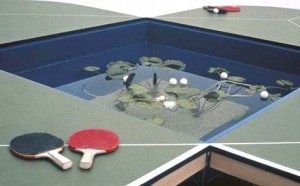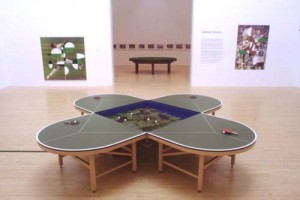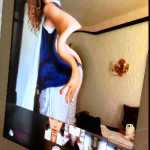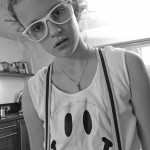http://youtu.be/xX4XN-9wjf4 And the not-so-little girl did it again - fortunately I got this little gem…
Ping Pond play
 Sometimes serendipity happens. Thinking about making a ping-pong table with a double field of vision, I came across ‘ping pond table’ by Gabriel Orozco (1998, on display at Common Wealth, Tate Modern, 2003).
Sometimes serendipity happens. Thinking about making a ping-pong table with a double field of vision, I came across ‘ping pond table’ by Gabriel Orozco (1998, on display at Common Wealth, Tate Modern, 2003).
This is what art Elizabeth Coulter-Smith had to say about it in an essay she published in 2005:
Deconstructive play is currently a major theme in contemporary fine art, but in general fine artists play with themselves. Creating game-like or playful interactivity is woefully underdeveloped in the sphere of fine art. Generally speaking despite rhetoric regarding ‘art into life’, ‘social sculpture’ or ‘relational aesthetics’, fine art remains devoted to the tradition of the ‘great artist’ and the role of the viewer remains that of admiring the heightened sensibility and ingenuity of such artists.When attempts are made by fine artists to involve the viewer they can appear derisory. One instance is the Common Wealth exhibition at Tate Modern, 2003, in which two works by Carsten Höller and Gabriel Orozco made attempts at interactivity. Höller’s work, Frisbee House, consisted of an igloo-like tent with holes cut into its fabric. The viewer was invited to throw Frisbee’s through the holes. Orozco’s contribution was a four-sided table-tennis game with a water lily pond in the middle. Will the balls land on the water or on a water lily? The only remarkable feature of either of these works was that the viewer was released from the usual lap-dancer ‘you can look but don’t touch’ regime of the art museum. What was missing was any degree of ingenuity. It was as if these two celebrated artists were unable to open up the viewer’s creative process beyond the level of a three-year old. This is especially strange because Orozco has played many simple yet interesting formal games by himselfsuch as making a clay heart out of his hands or creating a sculptural object by rolling a ball of clay over a grid. Fine art is much more successful when it comes to involving the spectator’s visual perception: the level of the disembodied gaze. For example Carsten Höller created an interactive installation in which the participants wore special spectacles that turned the world upside down. In another installation he used a wall-sized field of light bulbs flashing on and off at alpha brain-wave frequency to induce a feeling of well-being in the viewer.
Well, yes, mrs Coulter-Smith, this is exactly why I am having a hard time trying to create an interactive, playful environment that does require a degree of ingenuity.
The artist himself (Orozco, ‘Games‘): The ‘Ping Pond Table’ is connected to this idea of a new space, a new possible space. When you have a normal ping poing game you have a net which is enough space between two spaces. But when you multiply that space by four, instead of two people playing you have four people playing in four tables. You open that space so the net is also open. And what you have there is a new space, because it didn’t exist before… the net, that space in between two spaces – I opened it up. And I have a tri-dimensional space now in-between four spaces. That is the space that I’m interested in, the in-between space … To activate that space. To activate means to fill it with meaning and connections so that we can think about it. We can connect with it and make it happen as a space and time in beween things.
…games, because they have this reference, are expressions of how we believe the universe works in different cultures. We know that chess has that and billiards has that. Ping pong has that too. Every game has a connection to how we conceive nature and landscape. How we order and we structure reality.
.. Probably they are more like philosophical games. I believe that philosophy has to be a practice. Practical philosophy. It’s like the way the Greeks used to solve philosophical and mathematical problems, by walking. Not sitting. It’s easier to solve problems moving—when you walk and you talk—probably because you have better irrigation in the brain or just because you are breathing better. Because you are moving you have better chances to solve complex problems. And also I think in a way it’s an action thing. So I think philosophy is an action, it should be. And to play the games are part of it.
| « Up up up | <-- previous post | next post --> | Immersed perception and artistic games » |
|---|








